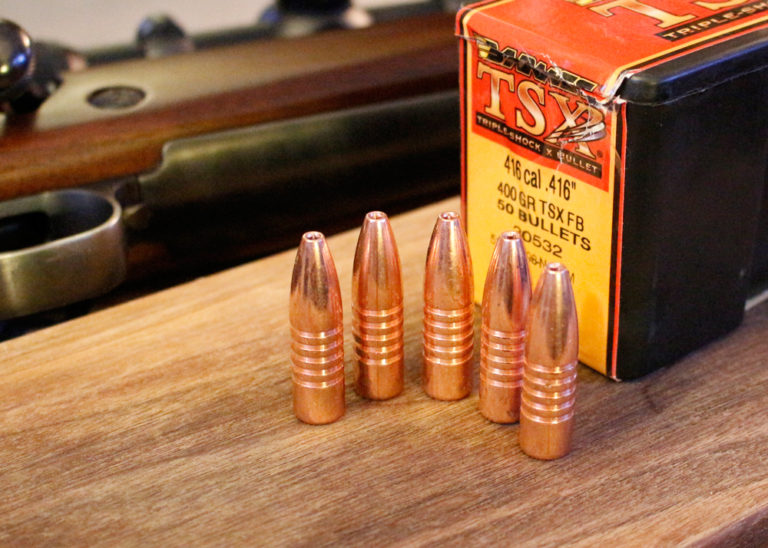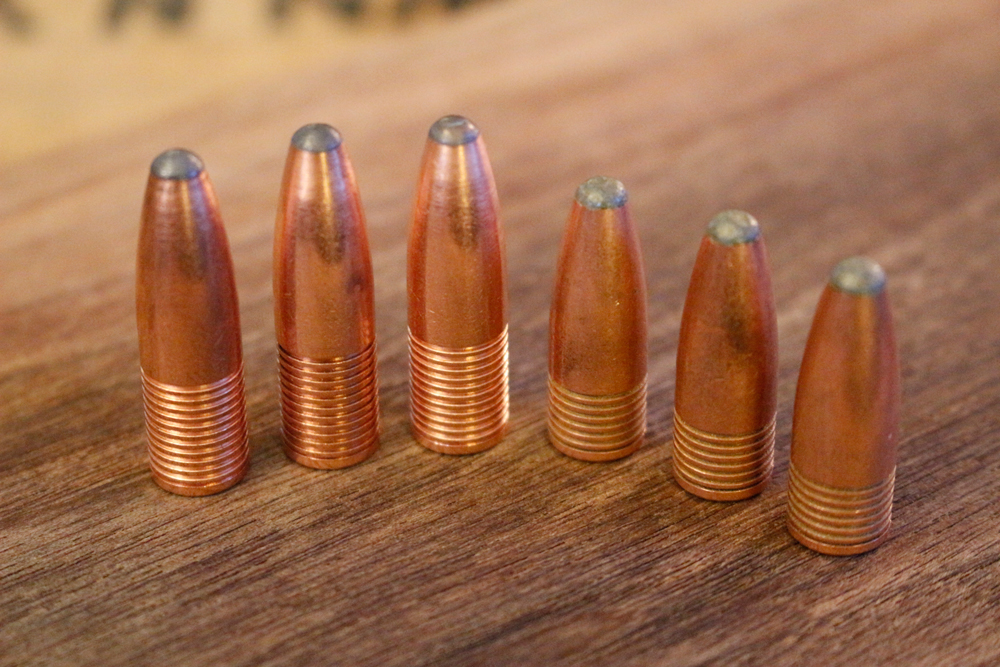
 There have been a number of advancements in bullet design in the modern day. One of the most elegant and effective has been the advent of the bullet groove.
There have been a number of advancements in bullet design in the modern day. One of the most elegant and effective has been the advent of the bullet groove.
The bullet is changing. It is happening slowly, but it is happening. Take for instance the bullet groove.
The last twenty or so years have seen a couple of trends: firstly, the perfection of the monometal bullet, and secondly the adoption of the bonded core. Let’s talk monometals first.
Initially, I loved the concept. You have a projectile that is built of solid copper, much harder than lead, which simply won’t come apart. The problems associated with jacket separation were a thing of the past.
The only problem with these early monometals was the fact that they didn’t shoot well at all. The problem was solved by cutting grooves into the shank of the bullet, to reduce the bearing surface, and thereby reducing pressures and coincidentally increasing accuracy. The hollowpoint opens reliably, and it gives us hunters something to ponder.
The acceptable minimums, set forth by the shooting experts of 50 or more years ago, need to be reestablished. In other words, the rifles and cartridges, and even bullet weights for that matter, that were considered marginal in years past, are no longer marginal.
A good example is the .270 Winchester as an elk cartridge, which in the past has been considered too light. The monometal bullet has changed that idea; a good 140- or 150-grain monometal bullet will neatly dispatch any elk God ever put on earth. Another way of looking at it is from the bullet weight perspective. The performance of a .308 caliber, 150- or 165-grain monometal will be on par with a 180-grain cup-and-core. That changes things.
Now, about those bonded core bullets. By chemically bonding the core to the jacket, you get a bullet that will expand reliably, but the bonding process prevents any separation.
The shank with a bullet groove shows its face again in the bonded core realm in the guise of the North Fork bullet. There are many little grooves along the shanks of these bullets, again reducing pressure and showing fantastic accuracy. My 6.5-284 Norma has put five 140-grain North Fork hollowpoints into ½ MOA routinely.
The dangerous-game solids also have this bullet groove feature, with the Woodleigh Hydrostatically Stabilized Solid coming quickly to mind. You’re starting to see a trend here.
How does this affect us handloaders? Well, in a couple of different ways.
When loading for these bullets you’ll see that the lower pressures they deliver can lead to a change in required powder loads. North Fork recommends lowering the powder charge by 4 percent or so to arrive at the same ballistics associated with bullets that have a smooth shank, while Woodleigh recommends using identical load data will give good results.
If you take a glance at the Barnes Reloading Manual, you’ll notice quite a few of the loads are compressed. This is mainly due to the fact that the copper bullets are longer than the cup-and-core bullets, and eat up a bit more of the case capacity. However, the manner in which the TSX and TTSX build pressures allow you to achieve the same velocities with less powder.
I have found the best accuracy with Barnes bullets while using the faster-burning powders. When it comes to grooved North Fork bullets, they are a bit of a different animal. They keep their weight forward, allowing for more case capacity, rather than less, and the tiny grooves will actually help to keep your barrel cleaner, longer.
As a matter of interest, the folks at North Fork have told me stories of bench rest shooters using the North Fork bullets as a ‘cleaning round’ to keep the bore clean in between round of match grade bullets. The North Fork company does not produce a reloading manual, so you’ll have to use other data and start from the bottom end of the spectrum until you find your accuracy level and speed you’re after.
These newer designs are here to stay, and I’m glad, because they have proven to be both very accurate, and to perform well on game animals. They just need to be handled with a bit of a different mind set.

Next Step: Get your FREE Printable Target Pack
Enhance your shooting precision with our 62 MOA Targets, perfect for rifles and handguns. Crafted in collaboration with Storm Tactical for accuracy and versatility.
Subscribe to the Gun Digest email newsletter and get your downloadable target pack sent straight to your inbox. Stay updated with the latest firearms info in the industry.


![Best Concealed Carry Guns In 2025 [Field Tested] Wilson Combat EDC X9S 1](https://gundigest.com/wp-content/uploads/Wilson-Combat-EDC-X9S-1-324x160.jpg)


![Best 9mm Carbine: Affordable PCCs [Tested] Ruger Carbine Shooting](https://gundigest.com/wp-content/uploads/Ruger-Carbine-Shooting-100x70.jpg)
![Best AR-15: Top Options Available Today [Field Tested] Harrington and Richardson PSA XM177E2 feature](https://gundigest.com/wp-content/uploads/Harrington-and-Richardson-PSA-XM177E2-feature-100x70.jpg)

Interesting bullet. I am wondering if the handloader added Moly, or Graphite or plain old 50/50/ alox grease to the bullet if it would reduce fouling even further. I recently looked at some military Swiss 7.5 ammo and it had a wax ring around the base of the bullet at the case neck juncture but the bullet had no groove to hold the lube there. The Swiss bullet needed the wax as it had a cupro-nickle jacket which without such wax would quickly foul out the bore with very hard to remove fouling.